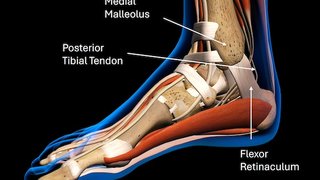Hip dysplasia is not just a condition that affects your dog
June 21, 2019

Hip dysplasia is a term most people associate with their dogs, particularly if they own a large breed. But the condition, which occurs when the hip socket and ball portion of the upper thigh bone don’t fit together correctly, occurs with some frequency in humans, too.
An estimated 1 in 10 people are born with some form of hip instability, and hip dysplasia is the leading cause of hip arthritis in young women. Hip dysplasia is also the most common abnormality among newborns, according to the International Hip Dysplasia Institute.
June is Hip Dysplasia Awareness Month, which makes it a perfect time to discuss the genesis of this complex condition and how our multispecialty team at UT Southwestern is conducting research that has already led to an important discovery about the effects of hip dysplasia. We have also received a grant that will allow us to build a comprehensive hip database, which has the potential to advance treatment of this condition and save thousands of patients from hip replacement surgery in the future.
Causes and symptoms of hip dysplasia
Most people who have hip dysplasia are born with it or have risk factors that may predispose them as they develop. Doctors will typically check for the condition in infants and on regular visits during a child’s first year.
The hip joint is made of soft cartilage when you’re born, and it hardens into bone as you grow. But if the ball and socket don’t form together properly, the socket can end up being too shallow, causing hip instability. There are several causes for this, all related to reduced and limited space inside the womb. Hip dysplasia can occur when:
- The baby is in a breech position
- It’s a first pregnancy
- The baby is large and there is limited amniotic fluid
Symptoms of hip dysplasia can vary depending on age:
- A baby might have one leg that’s longer than the other
- Children might have one hip less flexible than the other
- Teens or adults may experience hip pain, clicking, or dislocations
These symptoms may be mild at first, only manifesting themselves during physical activity. But if they persist, it’s important to see a physician or hip specialist. Too many patients deal with pain for years, until it becomes so intense it limits their mobility. The danger of waiting is that the muscles around the hip weaken, bones change shape, and osteoarthritis takes hold as the body tries to stabilize the hip.
Uncovering more knowledge about hip dysplasia
While much is known about hip mechanics – it is the largest ball and socket joint in the body - little is known about how those mechanics affect the hip on a cellular, radiographic, and clinical level.
The hip joint is formed by the head of the femur, or thigh bone, fitting into the acetabulum, or socket, of the pelvis. (Acetabulum actually translates to “vinegar cup” in Latin, and that’s an apt description of the function it performs. The “cup” holds the hip’s ball joint in place.) But when the ball and socket don’t grow in unison, it can lead to hip dysplasia.
In order to properly treat and restore a dysplastic hip, it’s important to first identify the anatomic abnormalities involved.
A change in the biomechanics of the hip can lead to axial overloading, causing too much pressure on the rim of the hip joint. Left untreated, it can lead to osteoarthritis and the need for hip replacement at a very young age.
Our preliminary research has already led to the discovery of the presence of a protein in the cartilage of hips that causes osteoarthritis. In many cases, this protein is responsible for joint degeneration and is often found in advanced arthritis.
Our research has also shown that this protein is significantly increased in hip dysplasia patients, including those in the early stages of osteoarthritis. This novel finding is backed by our active research in 3D motion technology and real-time gait analysis studying hip mechanics and how certain destructive proteins respond to mechanical forces.
Finding a link between proteins and the progression of cartilage degeneration could be the first step toward finding a way to slow or reverse osteoarthritis and hip degeneration.
How do you treat hip dysplasia?
Treatment for hip dysplasia is dependent on the patient’s age and level of discomfort.
In infants, a brace or harness may be used to hold the hips in proper position. If it’s caught early enough, this corrective measure may be all that’s needed.

In mild cases of dysplasia in children and younger adults, nonsurgical treatments can include weight loss strategies, joint injections, and physical therapy. Patients can also alter their activities, for instance choosing swimming instead of running to put less stress on the hip joints.
Surgery known as periacetabular osteotomy (PAO) is a viable option for teens and adults who have hip dysplasia but haven’t experienced significant deterioration of their hip cartilage.
In PAO surgery, the hip bones are cut and the socket is repositioned. Screws are used to hold the socket in place until the bone heals. Precise understanding of the bony deficiency pattern is important to accurately correct the underlying deformity.
One type of PAO, the Bernese periacetabular osteotomy, is becoming more popular among hip surgeons who want to spare as much of the natural hip structure as possible. This procedure is typically offered to people between the ages of 10 and their early 40s.
Tracking hip dysplasia for the future

Even with the discoveries of the novel protein, we do not know if this can actually preserve a hip on the cellular level. We always try to preserve the hip before we do surgery.
At UT Southwestern, we are committed to studying the long-term outcomes of our hip-preservation procedures. We already have more than 1,000 patient surveys on file in our comprehensive database, and as we expand our research and track the progress of patients over the next few decades, our hope is that the findings will educate providers and patients, as well as benefit future patients.
Ultimately, our hope is that 10 or 20 years from now we will see patients who once faced the prospect of a full hip replacement living pain free because of the preservation efforts and research of our multidisciplinary hip dysplasia team.
It’s a great time of investigation and discovery at UT Southwestern, and we plan to be leaders in the evolution hip dysplasia treatment.
If you or a loved one are experiencing symptoms of hip dysplasia, you can request an appointment with one of our specialists online or call 214-645-8300.










